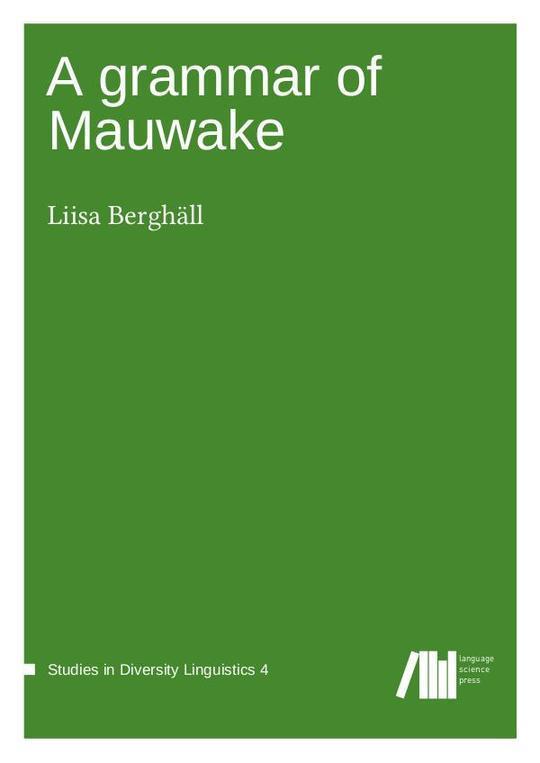
A grammar of Mauwake
Free
Description
Contents
Reviews
Language
English
ISBN
978-3-946234-27-2
Acknowledgements
Abbreviations and symbols
Introduction
Background
Purpose and theoretical orientation of the study
Purpose
Theoretical considerations
Audience
On the data and examples
The Mauwake people, their environment and culture
Geography and administration
On the history of the Mauwake people
Demography
Economy
Cultural notes
Mauwake kinship system
The Mauwake language
Genealogical affiliation and previous research
Typological overview of morphological and syntactic features
Mauwake as a lan]Trans New GuineaTrans New Guinea language
Mauwake as an sov language
Dialects
Phonology: a brief overview
Phonemes
Consonants
Vowels
Suprasegmentals: stress and intonation
Stress
Intonation
Orthographic symbols
Syllables and phonotactics
Syllable patterns
Vowel sequences
Consonant sequences
Word
Defining a phonological word in Mauwake
Distribution of syllables in a word
Morphophonology
Elision of word-final vowel
Reduplication
Type 1
Type 2: v1c1v1 - v1c1v2c2v(v3)x
Type 3: v1v1c1 - v1v1c1v2x
Type 4: c1v1v2 - c1v1v2x
Unusual reduplications
Past tense and medial verb suffixes
Inchoative suffix
Completive aspect marker
Loan words
Morphology
Introduction
Nouns
General discussion
Nouns and adjectives: one or two word classes?
Common vs. proper nouns
Alienable and inalienable possession
Noun compounding
Derived nouns
Action nominals
Noun reduplication
Adjectives
Quantifiers
Numerals
Non-numeral quantifiers
Pronouns
Introduction
Free pronouns
Unmarked pronouns
Focal pronouns
Accusative pronouns
Genitive pronouns
Dative pronouns
Isolative pronouns
Restrictive pronouns
Reflexive-reciprocal pronouns
Comitative pronouns
Primary and secondary reference of personal pronouns
Use of personal pronouns in text
Spatial deictics
The basic spatial deixis in Mauwake
Demonstratives
Deictic locative adverbs
Deictic manner adverbs
Question words and indefinites
Question words
Indefinites
Verbs
General discussion
Definition
General characteristics of verbs in Mauwake
Verb structure
Verb derivatives
Derivation vs. inflection
Category-changing derivation: verb formation
Zero verb formation
Inchoative suffix
Category-maintaining derivation: suffixes
Causative suffix
Distributive suffix
Benefactive suffix
Derivational prefixes
Reduplication
Bring-prefixes
Verb inflection
Beneficiary
Counterfactual
Mood
Indicative
Imperative
Tense and person/number in final verbs
Medial verb marking
Same-sbj]subjectsubject marking
Different-sbj]subjectsubject marking
Tense and sbj]medialmedial verbs
Verb classes
Conjugation classes
Verb classes based on transitivity
Intransitive verbs
Transitive verbs
Ambitransitive verbs
Object cross-referencing verbs
Valence changes
Causatives
Benefactive
Decreasing semantic valence
Semantically based verb classes
Stative/existential verb ik-
Position-taking verbs
Location verbs
Resultative verbs
Directional verbs
Utterance verbs
Impersonal experience verbs
Auxiliary verbs
Verbal clusters
Verbal groups
Main verb plus sbj]auxiliaryauxiliary: aspect
Completive aspect
Continuous sbj]aspectaspect: sbj]progressiveprogressive and habitual
Stative aspect
Serial verbs
Adjunct plus verb constructions
Nominal adjunct plus verb
Adverbial adjunct plus verb
Adverbs
Material adverbs
Locative adverbs
Temporal adverbs
Manner adverbs
Intensity adverbs
Modal adverbs
Free adverbs
Negators
Connectives
Pragmatic connectives
Semantic connectives
Postpositions and clitics
Comitative clitic and postpositions
Reason postposition muuta (nain)
Comparison postposition saarik
Locative clitic -pa
Instrumental clitic -iw
Limiter -iw
Topic and focus markers
Topic markers
Focus clitics
Question marker
Co-occurrence of the clitics
Interjections
Phrase level syntax
Noun phrase
Basic noun phrase
Coordinate noun phrase
Comitative noun phrase
Appositional noun phrase
Adjective phrase
Quantifier phrase
Possessive phrase
Verb phrase
Adverbial phrases
Locative phrases
Temporal phrase
Manner phrase
Clause
Order of constituents
Syntactic arguments
Transitive clauses
Monotransitive clauses
Ditransitive clauses
Inherent ditransitivity
Derived ditransitivity
Possessor raising
Intransitive clauses
Existential and possessive clauses
Existential clauses
Possessive clauses
Verbless clauses
Equative and classifying clauses
Descriptive clauses
Negated existential and possessive clauses
Nominalized clauses
Type 1: with a nominalized verb
Type 2: with a finite verb
Functional domains
Modality
Epistemic modality
Deontic modality
Negation
Clausal negation
Constituent negation
Negative interjection
Other cases of negation
Deixis
Person deixis
Locative deixis
Temporal deixis
Quantification
Quantification in the noun phrase
Quantification devices in the verbs
Comparison
Comparison of inequality: comparative constructions
Comparison of similarity: equative constructions
Sentence types
Statements
Questions
Non-polar questions
Polar questions
Echo questions
Confirmation questions
Indirect questions
Rhetorical questions
Answers to questions
Commands
Clause combinations
Coordination of clauses
Conjunction
Juxtaposition
Conjunction with coordinating connectives
Disjunction
Adversative coordination
Consecutive coordination
Causal coordination, ``afterthought reason''
Apprehensive coordination
Clause chaining
Chained clauses as coordinate clauses
Temporal relations in chained clauses
Person reference in chained clauses
Partitioning of the participant set
Tracking a subject high in topicality
Apparent mismatches of reference
Medial clauses as a complementation strategy for perception verbs
Tail-head linkage
Subordinate clauses: embedding and hypotaxis
Relative clauses
The type and position of the relative clause
The structure of the relative clause
Relativizable noun phrase positions
Non-restrictive relative clauses
Complement clauses and other complementation strategies
Complements of utterance verbs
Direct speech
Indirect speech
Desiderative clauses
Purpose clauses
Conative clauses: `try'
Complements of other utterance verbs
Complements of perception verbs
Complements of cognitive verbs
Complement clauses as subjects
Adverbial clauses
Temporal clauses
Locative clauses
Adversative subordinate clause
Conditional clauses
Concessive clauses
Coordination of subordinate clauses
Theme, topic, and focus
Theme
Topic
Introducing a new topic
Maintaining an established topic
Re-activating an earlier topic
Highlighted topic
Focus constructions
Contrastive focus
Neutral focus
Other focusing devices
Appendix
List of main texts used
Texts
World War 2
Uncle Tup
Catching a turtle
Fishing customs
Dog and snake
Piglet
Man’s lover
A flood story
Copra work
Garden work
Girls’ initiation customs
Funeral customs
Tidal wave
References
Index
Name index
Language index
Subject index
The book hasn't received reviews yet.


